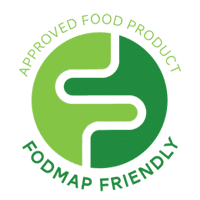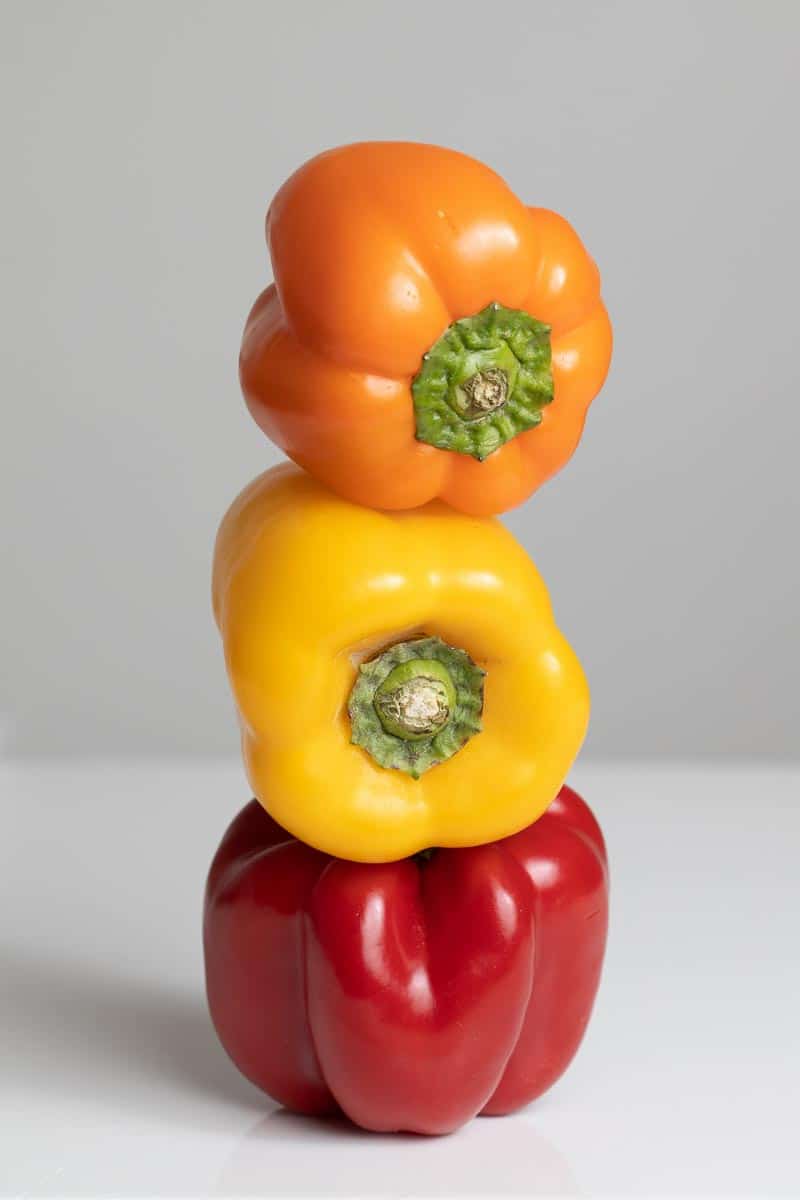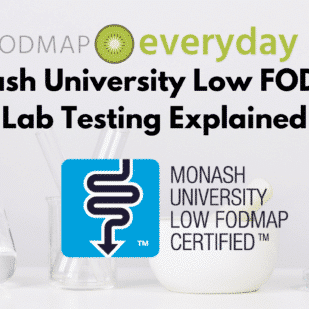The FODMAP Friendly smartphone app contains much more than a mere list of foods and their FODMAP content, but that is what are focusing on in this post. Also please read our articles, FODMAP Friendly Lab Testing Explained, Meet FODMAP Friendly: Eat with Confidence, and All About The FODMAP Friendly Recipe Maker.
This article was updated September 2024 along with the app’s new overhaul, and their debut of their Recipe Maker system.

FODMAP Friendly, by the way, is a trademarked term (note the caps on “Friendly”) and we do not use the term casually. When we discuss a food or product and call it FODMAP Friendly, it means it has been lab tested by FODMAP Friendly.
Click HERE to read more about what else the FODMAP Friendly app has to offer in their words.
We Highly Recommend The FODMAP Friendly App
There are two apps that we think everyone following the low FODMAP diet should have: the FODMAP Friendly app and the Monash University app. This is because these are the two entities that are doing the original lab testing, for which we are eternally grateful. All other apps are using derivatives of this information, and it is often not presented well, not in its entirety, is not up-to-date, and/or lacks the nuances present in these primary resources.
Items Only Found In The FODMAP Friendly App
Did you know that the FODMAP Friendly app contains information not found anywhere else? At the time of writing there are many such entries – Red Flame grapes, black grapes, grana padano cheese, psyllium, banana peppers, purple, white and yellow carrots, and prosciutto, to name a few – and many commercially prepared products that are lab tested and certified low FODMAP by FODMAP Friendly. (In fact FODMAP Friendly had lab tested yellow peppers, yellow summer squash, A2 milk, mirin and kombu way before Monash, for more examples). You need this app!
Look For The Icon
By the way, if you see this icon below on a prepared product, it means it was lab tested and certified low FODMAP by FODMAP Friendly. Regardless of the ingredients (there might a little honey for instance) the product is guaranteed low FODMAP at the serving size suggested.

FODMAP Friendly Smartphone App System
Here is the initial interface that you will see when you open the FODMAP Friendly app.

If you click on the question mark, upper right, you will see this screen below. You can read about FODMAP Friendly Certified products, access Recipes using their products, and more.
Check out our article, How To Read A Low FODMAP Certified Product Label, for more info on that in particular.

But let’s get back to that initial screen and press on the Food List box, top left – or you can access the Food List from the screen shown above.
The FODMAP Friendly Food List
You will then be brought to all the food categories, in alphabetical order. Looking for FODMAP content of Beverages? Click there. Looking for Dairy & Alternatives, or Snacks? There are all one click away. You get the idea.

Let’s look at Fruit.
The interface shows color images, also in alphabetical order, of the fruits that have been lab tested. If a fruit is not listed, it has not been tested.

Let’s look at green kiwi:

One of the main features that we love about the FODMAP Friendly app is that they very clearly show us the percentages of FODMAPs detected in lab testing. These percentages are based upon thresholds that are known to trigger IBS in most people. Green kiwi show 45% fructans, per suggested serving size of 150 g.
All foods are tested for Sorbitol, Mannitol, Fructans, GOS, Lactose and Excess Fructose.
With the new app updated (September 2024), you can see everything at once: the low FODMAP serving size (which is often established by government guidelines and has nothing to do with FODMAPs), and the maximum serving that remains low FODMAP – 333 g. We LOVE this feature.
One of the main features that we love about the FODMAP Friendly app is that they very clearly show us the percentages of FODMAPs detected in lab testing. These percentages are based upon thresholds that are known to trigger IBS in most people.
Let’s look at a food where no FODMAPs were detected – arborio rice:

What does it mean to you, when a food contains FODMAPs, or perhaps none at all?
Before we get to that, let’s look at an item that has a high FODMAP content – ripe common bananas:

For a 150 g (5.29 ounce) serving size we can see that the threshold for fructans is 170%; this is why they get a red “Fail”. This amount of fructans would likely trigger IBS symptoms in most people.
Now you can see that there is a green box that says, Can I Have Some? The FODMAP Friendly system shows us that 88 g (3.1 ounce) of ripe common banana is low FODMAP. Always remember that the diet is very much about serving size; foods can have both high and low FODMAP servings.
Having a digital scale is extremely helpful to have when following the low FODMAP diet.
How To Use The FODMAP Friendly App Percentages
You could manually add up the percentages. Let’s look at examples:
Here is an example of a low FODMAP snack, with the serving sizes and FODMAP percentages taken from the app. No other app on the market provides you with this information.

Here is an example of a high FODMAP snack, with the serving sizes and FODMAP percentages taken from the app. The combination of blueberries and blackberries creates a snack that is over 100% for Excess Fructose.

We created these graphs for ourselves and you to see how you can use the percentages, but you no longer have to do this manually.
The FODMAP Friendly Recipe Maker

The debut of The FODMAP Friendly Recipe Maker appeared during the September 2024 overhaul of the app. Please refer to these articles to see how this new automated feature can make those FODMAP stacking calculations for you!
- How To Use The NEW Recipe Maker Function on the FODMAP Friendly App
- All About The FODMAP Friendly Recipe Maker
You won’t have to manually create graphs anymore like we did above. Whether you want to know if a snack is low FODMAP, or an entire recipe, the Recipe Maker can help.
Extrapolations
The FODMAP Friendly app contains a lot of information, but of course there will always be items that you are interested in that are not represented. What do you do if a food is not on either app, but is similar to a food that has been lab tested? For instance, what about orange bell peppers? Green bell peppers, red and yellow have been lab tested, but not orange.
Extrapolations can be tricky, as the FODMAP content of a food is unknown until it is lab tested.
We have an article for you that will be very helpful with this: What If A Food Hasn’t Been Lab Tested For FODMAPs?

Let’s look at a few similar foods:
- Green peppers: In initial tests, Monash reported that they contained sorbitol. In subsequent tests they reported fructans. FODMAP Friendly lab tests show fructans, GOS and sorbitol.
- Red peppers were originally reported by Monash to contain no FODMAPs, and fructans and GOS according to FODMAP Friendly. In subsequent tests, Monash reported that red bell peppers contain fructose. Do you think you can guess by looking what is in another variety of the hundreds of peppers available? (For the record, the answer is No).
- Ripe bananas contain much higher FODMAP content than unripe.
- Guavas are the opposite. Unripe are very high FODMAP (fructose), according to both Monash University and FODMAP Friendly, and ripe contain no FODMAPs detected at all, again according to both Monash and FODMAP Friendly.
- Green and red cabbages contain completely different FODMAPs. And Savoy and Chinese cabbage, which you might think would be more similar to Green cabbage, are both actually more akin to red cabbage.
- Fresh grapes contain no FODMAPs in certain lab tests, yet contain FODMAPs in other lab tests; raisins are high FODMAP.
- White flesh, yellow flesh and clingstone peaches showed different types of FODMAPs in lab tests.
- See what we mean?
We suggest that you do not try to extrapolate. If you cannot resist, then we suggest you extrapolate from known FODMAP information only when you are in your Challenge Phase, or beyond, and are stable.
And then, really, regardless of whether something is determined to be low FODMAP in a lab or not, most likely what you really want to know is whether a food might trigger symptoms for you.
Ask The Right Questions? Is It Low FODMAP vs. Can I Tolerate This? is the perfect article to read at this time.
FODMAP Lab Testing Articles At A Glance
Here are all of our other articles that pertain to lab testing for FODMAPs. We suggest that you read them all:
- Monash University Lab Testing Explained
- FODMAP Friendly Lab Testing Explained
- How To Use The Monash University Smartphone App
- When Monash University & FODMAP Friendly Lab Test Results Differ
- Meet FODMAP Friendly: Eat with Confidence
- All About The FODMAP Friendly Recipe Maker
The Takeaway
The FODMAP Friendly Smartphone App bring you a plethora of FODMAP information, straight from the researchers who do the lab testing, right to your fingertips.
Using the app is the most expedient and reliable way to keep up-to-date on FODMAP information. We think everyone who follows the diet should have this app. Period.
Please help us maintain the integrity of FODMAP Friendly. This is a trademarked term and we only use it to denote a food or food product that has actually been lab tested by FODMAP Friendly. In other words, we do not say something is “FODMAP friendly” in a casual sense.
We do not support any of the generic free FODMAP apps. They are deriving information from those who are actually doing the lab testing, which are FODMAP Friendly and Monash University. In our experience the extrapolation of the primary source information often means that it is watered down, often mis-represented, and also often out-of date.
Do yourself a favor and download the FODMAP Friendly smartphone app today, jump in, start using it, and you will be well on your way to following the low FODMAP diet as accurately and easily as possible.








